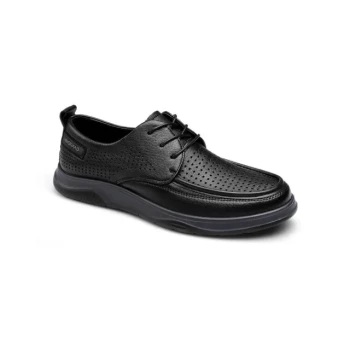In short, hiking shoe energy return is a feature, typically in the midsole, designed to absorb impact from your step and then rebound, using that momentum to help propel you into the next stride. The goal is to improve your walking efficiency over long distances, which can lead to reduced muscle fatigue.
While "energy return" focuses on enhancing forward momentum to reduce fatigue, the true measure of a hiking shoe is how it balances this feature against the critical needs for stability, protection, and grip on varied terrain.
The Goal of Energy Return: Hiking Efficiency
The concept of energy return comes from running shoe technology, where every bit of efficiency matters. In hiking, the goal is less about speed and more about endurance.
What It Aims to Achieve
Energy return technology uses specialized foam or composite materials in the midsole of the shoe. When you step down, this material compresses, and as you lift your foot, it springs back to its original shape.
This rebound effect gives a slight "push" forward, meaning your muscles don't have to work quite as hard to initiate the next step.
The Primary Benefit: Reducing Fatigue
Over thousands of steps on a long day hike, these small assists add up. The intended benefit is a noticeable reduction in the feeling of tired, heavy legs.
By making your gait more efficient, the shoe helps conserve your energy, allowing you to hike longer or feel better at the end of the day.
How Energy Return Fits into Shoe Design
Energy return is not an isolated feature; it exists within the complex system of a hiking shoe. Its effectiveness is directly related to the shoe's overall construction.
The Midsole Is Key
The midsole is the layer between the rugged outsole (that touches the ground) and your foot. Hiking shoes are known for having flexible midsoles, which is what allows for this "bouncy" or responsive feel.
The Link to Trail-Running Shoes
This technology is most prominent in footwear that blends hiking and running, such as trail-running shoes. Ultralight backpackers often favor these models specifically for their high energy return and low weight on long-distance journeys.
Understanding the Trade-offs
No single feature in footwear comes without a compromise. Prioritizing high energy return often means sacrificing other essential characteristics.
Energy Return vs. Stability
A shoe with a very soft, bouncy midsole can sometimes feel less stable on uneven or rocky terrain. The compression and rebound can lead to a slight feeling of unsteadiness.
In contrast, traditional hiking shoes and boots often have stiffer midsoles. They provide less energy return but offer a more planted, secure platform that protects against ankle rolls, especially when carrying a pack.
Flexibility vs. Foot Protection
The flexibility required for good energy return can be a downside on rugged trails. A key feature of hiking footwear is a stiff, rugged outsole that protects your feet from sharp rocks and roots.
An overly flexible shoe might feel great on a smooth path but can lead to sore, bruised feet after a day of hiking over pointed rocks.
Making the Right Choice for Your Hike
Choosing footwear isn't about finding the shoe with the most energy return; it's about matching the shoe's entire design to your intended use.
- If your primary focus is fast-paced hiking or ultralight backpacking on well-maintained trails: A hiking shoe or trail runner with high energy return could be an excellent choice to maximize efficiency.
- If your primary focus is hiking on technical, rocky, or off-trail terrain: Prioritize a shoe with a stiffer sole for protection and superior ankle support over maximum energy return.
- If your primary focus is general day hiking with a light pack: A balanced hiking shoe that offers moderate flexibility, good support, and decent energy return is likely the most versatile option.
Ultimately, understanding energy return allows you to make a more informed decision about how your footwear will support your specific hiking goals.
Summary Table:
| Feature | Benefit | Key Consideration |
|---|---|---|
| Energy Return | Reduces muscle fatigue, improves efficiency | May compromise stability on rough terrain |
| Flexible Midsole | Provides a responsive, 'bouncy' feel | Offers less protection from sharp rocks |
| Stability & Protection | Essential for technical, rocky trails | Often results in a stiffer, less energetic ride |
| Ideal Use Case | Best for fast-paced hiking on maintained trails | Not ideal for heavy packs or very uneven ground |
Ready to find the perfect balance of energy return, stability, and durability for your hiking footwear line?
As a large-scale manufacturer, 3515 produces a comprehensive range of hiking shoes and boots for distributors, brand owners, and bulk clients. Our production capabilities encompass all types of outdoor footwear, allowing us to tailor shoes that perfectly match your target market's needs—whether they prioritize high energy return for endurance or maximum protection for rugged trails.
Contact our experts today to discuss developing a high-performance, profitable hiking footwear collection.
Related Products
- Wholesale Durable Camouflage Canvas Shoes with High-Traction Cleated Rubber Sole
- Premium KPU Athletic Safety Shoes for Wholesale
- Wholesale Training Shoes with Dial Lacing System Custom OEM Manufacturing
- Durable Rubber-Soled Utility Shoes for Wholesale & Custom Brand Manufacturing
- Wholesale Breathable Training Shoes Custom Athletic Footwear Manufacturer
People Also Ask
- What are the benefits of using rubber soles on sneakers? Superior Grip, Durability & Comfort
- What are the characteristics of canvas as a shoe material? A Guide to Lightweight, Breathable Footwear
- Which type of sole is better for premium sneakers and why? The Definitive Guide to Rubber Outsoles
- Why should we wear rubber soled shoes? Unlock Superior Safety and Durability
- What are the advantages of mesh in athletic shoes? Unlock Peak Performance & Comfort



















